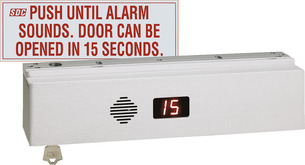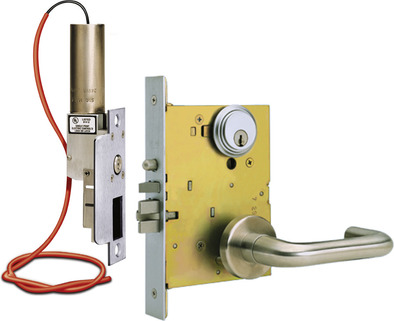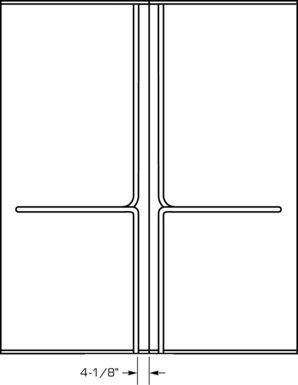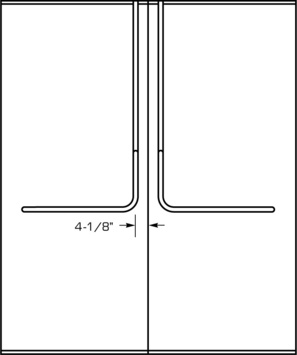Chapter 13. Specialty Electrified Locks
Chapter objectives
1. Learn about Unique Problem-Solving Locks in the Chapter Overview
2. Electrified Dead-Bolt-Equipped Panic Hardware
3. Discover Securitech Locks
4. Learn about Delayed Egress Locks
5. Learn about a Forgotten Problem Solver — Hi-Tower™ Locks
6. Get to Know a Rare but Useful Lock — Blumcraft™ Door Locks
7. Pass a Quiz on Specialized Electronic Locks
CHAPTER OVERVIEW
Sometimes there just isn't a solution to a locking problem. When you have looked through all of the normal locks that are made by all of the manufacturers and you cannot find a single lock solution to a nagging problem, it would be good to know that there are a few locks out there that just do not fit into the normal boring categories of most locks. These are weird and wonderful locks that can be real problem solvers.
In this chapter we will introduce Electrified Dead-Bolt-Equipped Panic Hardware, which allows for very secure locking of fire exit doors. We will also look at the bizarre and wonderful world of Securitech locks, which are some of the most creative and useful locks in the industry. The third section will be on Delayed Egress Locks, which provide for locking doors that could not be otherwise locked due to fire codes. The last two sections will deal with Hi-Tower locks, which are a good solution for fire-rated stairwells, and finally, we will introduce you to Blumcraft Door Locks, which are an elegant solution for frameless glass doors.
Sometimes there just isn't a solution to a locking problem. This chapter introduces Electrified Dead-Bolt Equipped Panic Hardware, which allows for very secure locking of fire exit doors. Also reviewed is the bizarre and wonderful world of Securitech locks, which are some of the most creative and useful locks in the industry. The third section of this chapter is about Delayed Egress Locks, which provide for locking doors that could not otherwise be locked due to fire codes. The last two sections deal with Hi-Tower™ locks, which are a good solution for fire-rated stairwells, and finally Blumcraft™ Door Locks, which are an elegant solution for frameless glass doors, are introduced.
Keywords: Blumcraft, Delayed Egress, Exit, Fire, Hardware, Hi-Tower, Panic, Securitech
Author Information:
Thomas L. Norman, CPP, PSP, CSC, Executive Vice President, Protection Partners International
Electrified Dead-Bolt-Equipped Panic Hardware
Remembering that Fire Exit Hardware (Panic Bars) must be used on all fire egress doors and all doors on any room with an occupancy of 50 or more, this would automatically rule out all electrified dead-bolt locks, wouldn't it? Well, perhaps not. If the need involves both security and safe egress to protect a room or corridor with important assets or higher security risks, a solution exists in the form of the Von Duprin Series HS99 Devices. This lock combines a Rim Exit Hardware device with a Sargent and Greenleaf 8470 Automatic Dead Bolt. The result is a high-security lock that provides single-action emergency egress from the inside. The lock can be used in a wide variety of situations requiring both emergency exiting and high security such as school buildings, pharmaceutical drug rooms, money counting areas, or Secured Compartmented Information Facilities (SCIFs). The lock can be dogged down during school hours to reduce maintenance and locked at night for security, while still providing emergency exiting.
When the lock is opened by pressing on the Panic Bar, both the Panic Bar Rim latch and the Automatic Dead Bolt retract, thus allowing exit. As the door re-closes and re-latches, a latchbolt sensor detects that the door is latched and power is enabled to re-lock the automatic dead bolt. These locks can also be operated by locking hardware from the outside, such as a key, combination lock, or keypad. A variance should always be requested from the Authority Having Jurisdiction (AHJ).
The lock can be used for exit only, key entry, combination lock entry, keypad entry, and electrically controlled entry.
Securitech Locks
Securitech is a most unusual lock manufacturer. The company began by building extremely robust locks for the New York Housing Authority, where housing residents were driving up the maintenance costs of multiple family housing units by destroying every lock the Housing Authority could find to put on their doors. It was common to find residents destroying lever sets by stressing them beyond their physical limits. The first Securitech locks used very robust mechanisms and clutches to allow the handle to rotate past its apparent limit without breaking it mechanically. When returned to its normal position by only the twist of the hand, it continued to function normally, thus confounding the most determined vandals.
It was not long before Securitech began electrifying their locks upon the request of their clients.
Today, Securitech also makes very high-security electrified locksets that meet fire codes. These include electrified multipoint dead-bolt locks that include panic bars, fitting the need for emergency egress on very high security doors.
Delayed Egress Locks
Where high security is required on a seldom used required exit door, the answer may be to use a Delayed Egress Lock (Figure 13.1). NFPA 101 makes a provision for this type of lock.
A Delayed Egress Lock is a specially modified magnetic lock that includes the magnetic lock, a countdown timer, exit sense device, a local alarm, Delayed Egress Signage, and a Fire Alarm Interface. The Delayed Egress Lock is designed to delay exit through a fire egress door for a predetermined time period (usually 15 to 30 seconds). A user approaches the door, pushes on a panic bar equipped with an exit sense switch, and holds the panic bar in while the countdown timer counts down to zero from the preset time. During that time, a local alarm at the door sounds to alert anyone nearby that a person is exiting the door. The alarm signals anyone nearby if a person is exiting while there is no emergency to facilitate compliance with the organization's security policy.
Delayed Egress Locks must be interfaced with the Fire Alarm System so that it unlocks automatically in event of a fire alarm in the area. It is usual to also see a Fire Alarm Pull Station located next to the Delayed Egress Door and to see a Wall-Mounted keypad or Card Reader to bypass the Delayed Egress Door delay and alarm to allow for passage of authorized users.
Hi-Tower Locks
Security Door Controls™ manufactures the problem-solving Hi-Tower Lock (Figure 13.2). This lock was originally intended to accommodate stairwell locking for access control, but its uses far exceed that application. The lock has the advantage of accommodating virtually any wood or hollow metal door application, including those where electric strikes, magnetic locks, and electrical bolt locks are not permitted.
For stairwell applications, electrified locksets and electrified exit devices are the only types of locks that can effectively lock the door and comply with fire and Life-Safety codes. Electric strikes are not acceptable because they do not latch when unlocked. Magnetic locks are not acceptable because they require a separate Request-to-Exit device to release the lock.
The Hi-Tower mortise lock is also unique because it does not require coring of the wood door or a cross-tube in a hollow metal door to accommodate wiring from an electric hinge to the mortise lock. The lock is a specially adapted standard mortise lock (available using many different manufacturers' lock bodies). The adapted mechanical mortise lock engages a specially designed “Frame Actuator Controlled” strike plate that has a small solenoid operated push button that sits flush with the strike plate when the door is open and retracts when the door is closed and locked. When the lock is commanded to release the latchbolt, the Frame Actuator pushes the corresponding button on the mechanical lock body, which releases the exterior handle to turn, enabling it to open the door. The inner door handle allows free mechanical egress at all times.
Hi-Tower locks will work in almost any wood or hollow metal door application, requiring minimal modification to existing doors and frames while providing a fail-secure application that can easily pass the review of just about all fire code officials.
CRL-Blumcraft Panic Hardware
Blumcraft of Pittsburgh is a company that makes tempered glass doors and panic exit devices for tempered frameless glass doors. These are beautiful and elegant locks designed to fit on beautiful and elegant doors (Figure 13.3).
Frameless glass doors are often used as the main entry doors of Class A commercial buildings. The doors are made from thick tempered glass plates usually having only a thin steel bottom and top rail. Front entry doors get a lot of use, so it is important to have hardware that allows for a great deal of activity and strength (consider durability).
A common way to secure frameless glass doors is by using magnetic locks; however, when panic devices are appropriate, rather than using conventional panic hardware on these beautiful doors, which would look out of place, CRL-Blumcraft of Pittsburgh manufactures a variety of panic bars that are stylish, strong, function well, and are mechanically and electrically lockable (Figure 13.4).
The first set shows variations of the top-latching Model DB-100 Series (Figure 13.5). The second variation shows the bottom-latching Model DB-110 Series. For the top-latching DB-100 Series the handles appear to be continuous, but the operating portion of this device pivots at the top and middle of the door hinge side, operating the mechanism by slightly moving the handle over the actuator post, which is just above the exterior pull bar. This retracts the latchbolt, allowing the door to open. When the door closes, the bolt re-latches automatically. All Blumcraft top-latching panic handles have a built-in dogging device, and are compatible with top-mounted electric strikes to allow for operation by an Electronic Access Control System. Blumcraft's bottom-latching DB-110 Series handles are not compatible with electric strikes.
Blumcraft of Pittsburgh was recently purchased by C.R Laurence Co., Inc., which now markets these products under the name of CRL-Blumcraft.
Chapter Summary
1. If the need involves both security and safe egress to protect a room or corridor with important assets or higher security risks, a solution exists in the form of the Von Duprin Series HS99 Devices. This lock combines a Rim Exit Hardware device with a Sargent and Greenleaf 8470 Automatic Dead Bolt. The result is a high-security lock that provides single-action emergency egress from the inside.
2. The first Securitech locks used very robust mechanisms and clutches to allow the handle to rotate past its apparent limit without breaking it mechanically. When returned to its normal position by only the twist of the hand, it continued to function normally, thus confounding the most determined vandals.
3. Today, Securitech also makes very high security electrified locksets that meet fire codes. These include electrified multipoint dead-bolt locks that include panic bars, fitting the need for emergency egress on very high security doors.
4. Where high security is required on a seldom used required exit door, the answer may be to use a Delayed Egress Lock. NFPA 101 makes provision for this type of lock.
5. Security Door Controls manufactures the problem-solving Hi-Tower Lock. This lock was originally intended to accommodate stairwell locking for access control, but its uses far exceed that application. The lock has the advantage of accommodating virtually any wood or hollow metal door application, including those where electric strikes, magnetic locks, and electrical bolt locks are not permitted.
6. Blumcraft of Pittsburgh (now CRL-Blumcraft) is a company that makes tempered glass doors and panic exit devices for tempered frameless glass doors. These are beautiful and elegant locks designed to fit on beautiful and elegant doors.
1) Electrified Dead-Bolt-Equipped Panic Hardware
a. Can be used on any room with an occupancy of 50 or more with a variance
b. Can be used on any room with an occupancy of 50 or more without a variance
c. Cannot be used on any room with an occupancy of 50 or more
d. Cannot be used in areas occupied by handicapped people
2) Securitech locks manufacture
a. Electrified cylinder locks
b. Simple magnetic locks
c. Locks that can be used on frameless glass doors
d. Electrified multipoint dead bolt locks that include panic bars
3) Delayed Egress Locks are approved by
a. Every Fire Marshall
b. Only in California
c. NFPA 80
d. NFPA 101
4) A Delayed Egress Lock comprises
a. A magnetic lock, a countdown timer, an exit sense device, and a local alarm
b. A magnetic lock, a watch-dog timer, an exit push button, and a local alarm
c. A magnetic lock, a watch-dog timer, a keypad, and a local alarm
d. A mortise lock, a watch-dog timer, an exit sense device, and a local alarm
5) Delayed Egress Locks
a. Count down exactly 30 seconds
b. Delay exit through a fire egress door for a predetermined time period
c. Should not be used on fire egress doors
d. None of the above
6) Hi-Tower Locks
a. Were originally designed to provide locking access to fire-rated stairwell doors
b. Were originally designed for frameless glass doors
c. Were originally designed for use on doggie doors
d. None of the above
7) Hi-Tower Locks
a. Require the door to be cored for their wiring
b. Do not require the door to be cored for their wiring
c. Require a separate magnetic lock
d. None of the above
8) Hi-Tower Locks
a. Can be used on glass doors
b. Can be used on hollow metal doors
c. Can be used on solid core doors
d. Can be used on either hollow metal or solid core doors
9) CRL-Blumcraft Panic Hardware
a. Was designed to provide locking access to fire-rated stairwell doors
b. Was designed for frameless glass doors
c. Was designed for use on doggie doors
d. None of the above
10) CRL-Blumcraft Panic Hardware
a. Is available for hollow metal doors
b. Is available for bottom latching
c. Is available for top latching
d. Is available in either top or bottom latching
Answers: 1) a, 2) d, 3) d, 4) a, 5) b, 6) a, 7) b, 8) d, 9) b, 10) d
..................Content has been hidden....................
You can't read the all page of ebook, please click here login for view all page.





